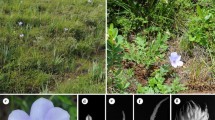Abstract.
The tribe Antirrhineae consists of 29 genera distributed in the New World and the Old. Phylogenetic analyses of ITS and ndhF sequences served to recognize six main lineages: Anarrhinum group (Anarrhinum, Kickxia); Linaria group (Linaria); Maurandya group (Cymbalaria, Asarina, Maurandella, Rhodochiton, Lophospermum); Schweinfurthia group (Pseudorontium, Schweinfurthia); Antirrhinum group (Antirrhinum, Pseudomisopates, Misopates, Acanthorrhinum, Howeliella, Neogarrhinum, Sairocarpus, Mohavea, Galvezia); Chaenorrhinum group (Chaenorrhinum, Albraunia, Holzneria). Parsimony (cladistics), distance-based (Neighbor-Joining), and Bayesian inference reveal that: (1) the tribe is a natural group; (2) genera such as Linaria, Schweinfurthia, Kickxia, and Antirrhinum also form natural groups; (3) three Antirrhineae lineages containing genera from the New and Old World are the result of three intercontinental disjunctions displaying similar levels of ITS-sequence divergence and differentiation times (Oligocene-Miocene); (4) evolution of flower shapes is not congruent with primitiveness of personate flowers; (5) both polyploidy and dysploidy appear to be responsible for most variation in chromosome number in the six main lineages. Nuclear and chloroplast evidence also supports the split of American and Mediterranean species of Antirrhinum into different genera, a result that should be contemplated in the interest of a more natural (monophyletic) taxonomy. Nucleotide additivity causes poor resolution in the ITS analysis of 22 species of Mediterranean Antirrhinum and lead us to interpret extensive hybridization in the Iberian Peninsula.
Similar content being viewed by others
Author information
Authors and Affiliations
Corresponding author
Additional information
This research was supported by the Spanish Dirección General de Investigación Científica y Técnica (DGICYT) through the project Flora Iberica (PS91-0070-C03-01). We thank Jorge Martínez and Emilio Cano for his assistance in the lab, Rafael Rubio and Omar Fiz for helping on the Bayesian inferences, the curators/collection managers of BCF, E, JACA, MA, SALA, SALAF, SEV, TARI, VAL for loans and access to specimens, and two anonymous reviewers for improving the quality of this publication.
Rights and permissions
About this article
Cite this article
Vargas, P., Rosselló, J., Oyama, R. et al. Molecular evidence for naturalness of genera in the tribe Antirrhineae (Scrophulariaceae) and three independent evolutionary lineages from the New World and the Old. Plant Syst. Evol. 249, 151–172 (2004). https://doi.org/10.1007/s00606-004-0216-1
Received:
Accepted:
Published:
Issue Date:
DOI: https://doi.org/10.1007/s00606-004-0216-1




